Monorepos
Lesson: Understanding Monorepos in Full-Stack Development
1. Introduction: Why Monorepos?
In modern full-stack development, applications often consist of multiple interconnected services, such as front-end and back-end applications, shared UI components, and utility libraries. Managing these separately in multiple repositories (polyrepo) can lead to:
- Dependency version mismatches (e.g., front-end and back-end using different versions of a shared API library).
- Complicated deployments (each repository needs separate CI/CD pipelines).
- Difficult code sharing (code reuse across services is cumbersome).
🚀 The Monorepo Solution
A monorepo (short for monolithic repository) is a single Git repository that stores multiple projects within it. Instead of managing multiple repositories for different parts of a full-stack application, everything is stored in one place, making development, collaboration, and maintenance easier.
Real-World Example:
Imagine a large e-commerce platform like Amazon. It has separate teams working on:
- A React-based front end (customer UI).
- A Node.js API (backend services).
- A shared authentication library used by both.
In a polyrepo setup, these would be separate repositories, leading to dependency mismatches. With a monorepo, all projects stay in sync, making collaboration smoother.
2. Understanding Monorepos
How Monorepos Work
Monorepos typically use workspace management tools to handle multiple projects efficiently. These tools ensure that dependencies are shared and optimized.
Popular Monorepo Tools
| Tool | Language | Use Case |
|---|---|---|
| Nx | JavaScript/TypeScript | Optimized for large-scale apps, caching, and task execution |
| Turborepo | JavaScript/TypeScript | Performance-focused, great for Next.js/React projects |
| Lerna | JavaScript | Works with npm/yarn workspaces for package management |
| Bazel | Multiple languages | Scalable for large enterprises like Google |
| pnpm Workspaces | JavaScript/TypeScript | Fast package management |
3. Key Benefits of Monorepos
1️⃣ Code Sharing & Reusability
In monorepos, teams can easily reuse code across projects. Shared libraries (e.g., authentication, UI components) stay in sync without extra work.
Example: A React component library can be shared between the front end and an admin dashboard without publishing it as an npm package.
2️⃣ Simplified Dependency Management
Since everything exists in one repository, dependencies remain consistent. If the back end and front end rely on the same API contracts, changes are synchronized.
3️⃣ Easier Refactoring
With a monorepo, refactoring is safer. Developers can update all affected projects at once, avoiding breaking changes across repositories.
Example: If the API changes from
/v1/usersto/v2/users, the front-end and back-end updates can be made in a single commit.
4️⃣ Improved CI/CD Pipelines
CI/CD systems (like GitHub Actions, GitLab CI, or Jenkins) can optimize workflows by running only the affected parts of the code.
Example: If a developer updates only the front end, tests and deployments run only for the front end, not the entire stack.
5️⃣ Stronger Collaboration & Visibility
Teams working on different aspects of the application (UI, API, DevOps) can see and contribute to changes in one place, improving teamwork.
4. When to Use (and Avoid) Monorepos
| ✅ Use Monorepos When... | ❌ Avoid Monorepos When... |
|---|---|
| You have multiple interconnected services | You have completely independent projects |
| Teams frequently share code/libraries | Teams work on separate, unrelated products |
| You need strict version control across projects | Your team prefers independent deployment cycles |
| You want a unified CI/CD pipeline | You have slow Git performance due to a large repo |
5. Common Pitfalls & Best Practices
❌ Pitfalls
- Slow Git Operations: Large monorepos can slow down Git operations. Use tools like Nx or Turborepo to optimize performance.
- Permission Conflicts: Teams might need different access levels for projects within the monorepo. Use Git submodules or branch-based access control if necessary.
- Overhead in Small Projects: For simple applications, a monorepo might be overkill. Use polyrepos if projects don’t need much interdependency.
✅ Best Practices
✔ Use Workspaces: Tools like Turborepo, Nx, Lerna, or pnpm workspaces help organize dependencies.
✔ Optimize CI/CD: Configure pipelines to build only affected projects instead of the whole repository.
✔ Keep a Clean Structure: Organize your monorepo by apps (apps/), shared libraries (libs/), and configurations (tools/).
✔ Automate Code Reviews: Use tools like Code Owners in GitHub to ensure the right teams review the right code.
6. Conclusion
- Monorepos streamline full-stack development, making dependency management, CI/CD, and collaboration easier.
- They are ideal for large projects where multiple teams work on interconnected services.
- Use tools like Nx, Turborepo, or Lerna to manage your monorepo efficiently.
- However, monorepos aren’t always the best choice—independent projects with separate lifecycles may still benefit from polyrepos.
Slides

Let's talk about Monorepos, which we are using in our tutorial code.

Full-stack applications often consist of multiple interconnected projects, such as the front end, back end, and shared libraries. Managing them separately in multiple repositories can lead to ...
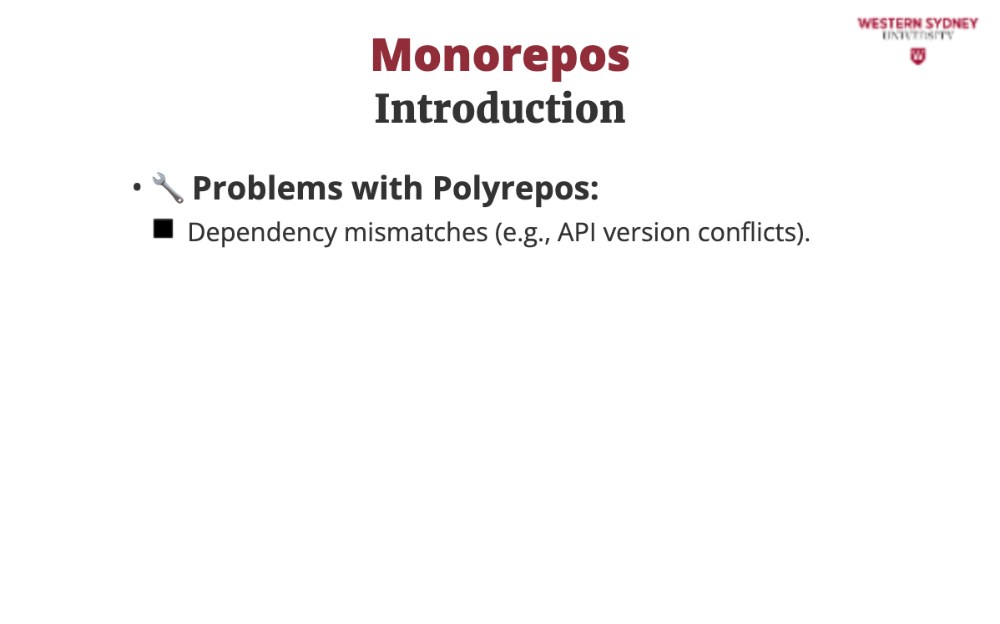
... version mismatches, where front-end and back-end use different versions of a shared API library
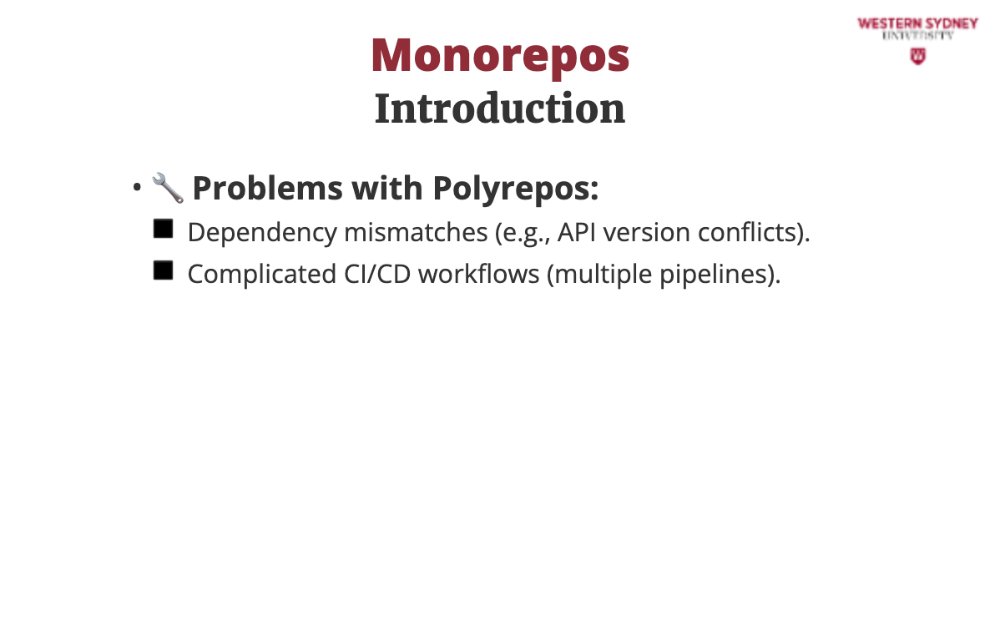
... complex deployments, where each repository needs separate CI/CD pipelines
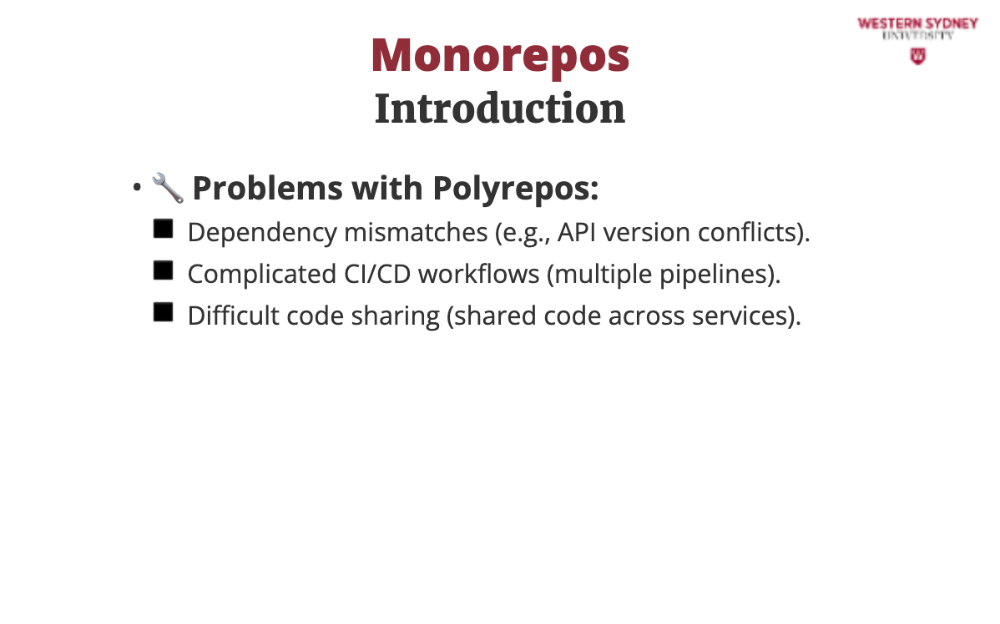
... and code duplication, where code reuse across services is cumbersome
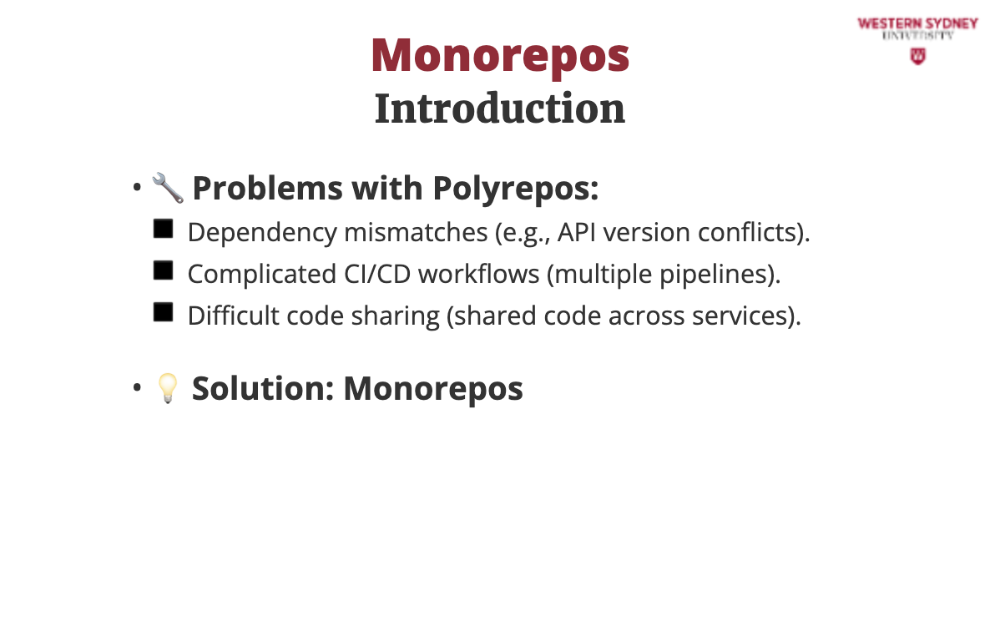
A monorepo (short for monolithic repository) is a single Git repository that ...
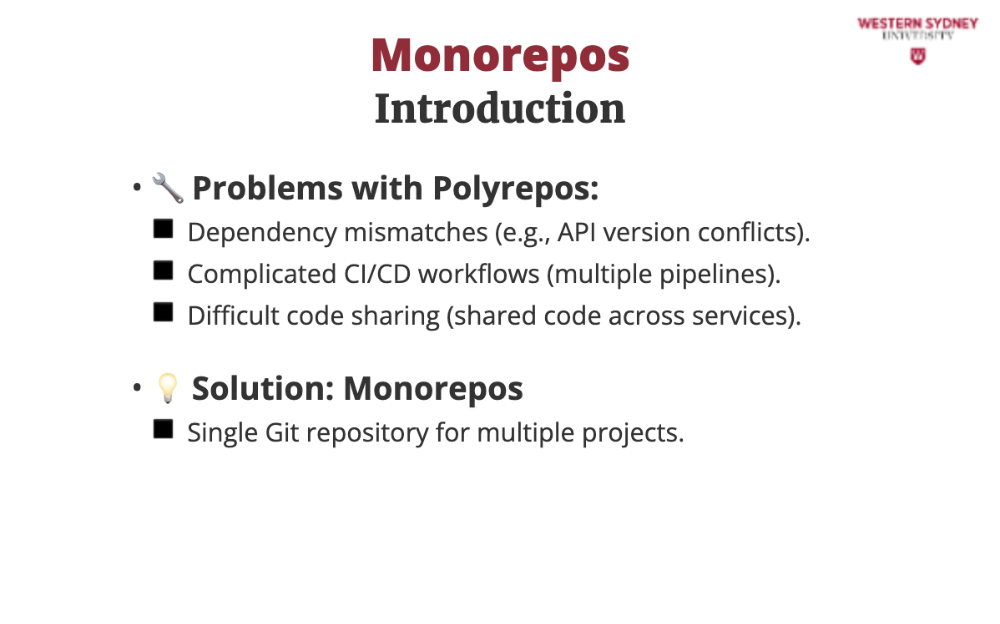
... stores multiple projects within it.
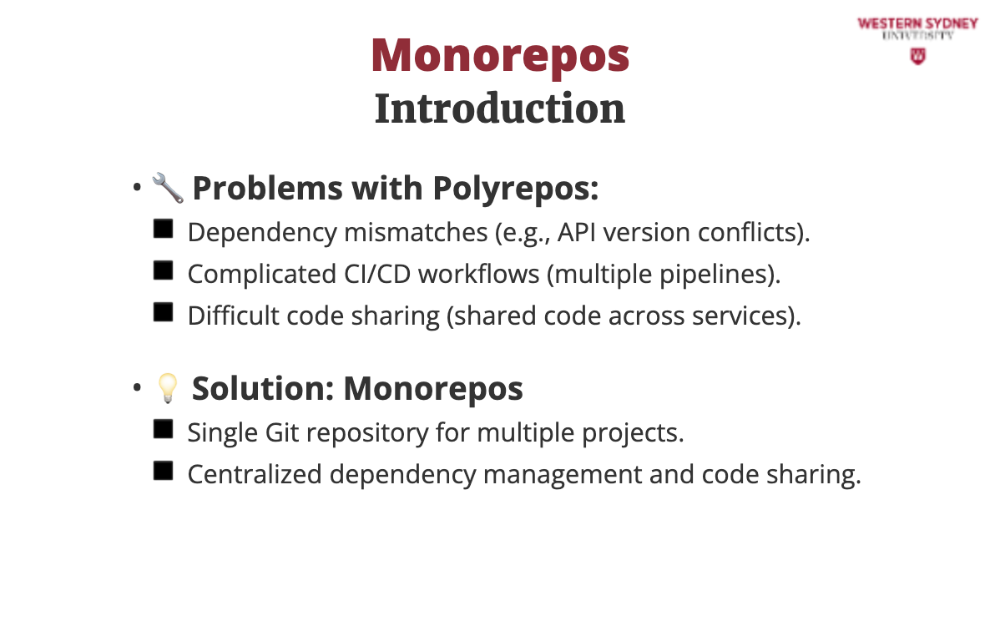
Instead of managing multiple repositories for different parts of a full-stack application, everything is stored in one place, making development, collaboration, and maintenance easier.
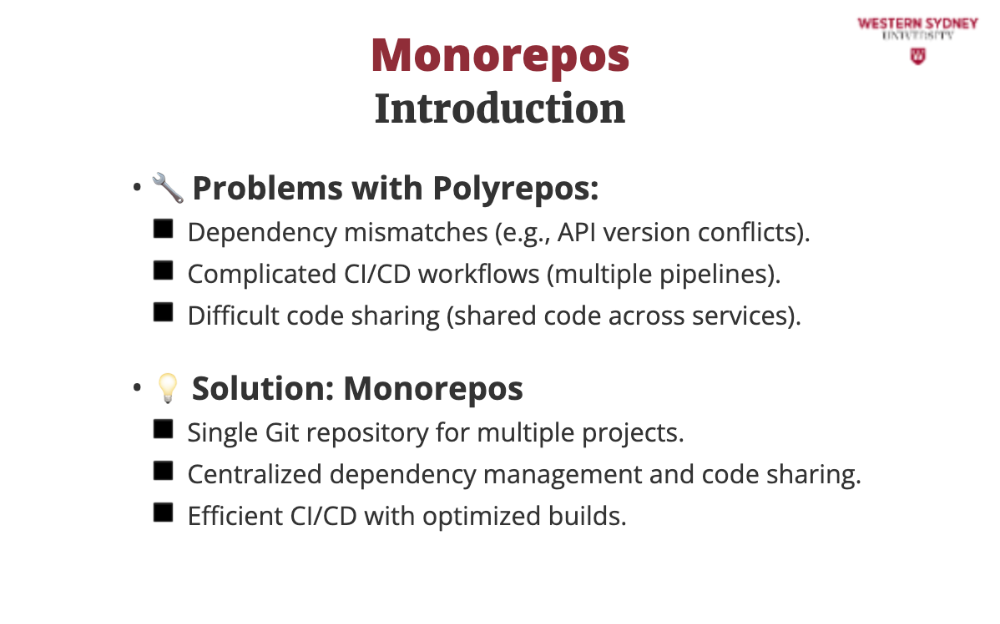
Moreover, your CI/CD pipelines can be optimised running only when dependent packages have changed.
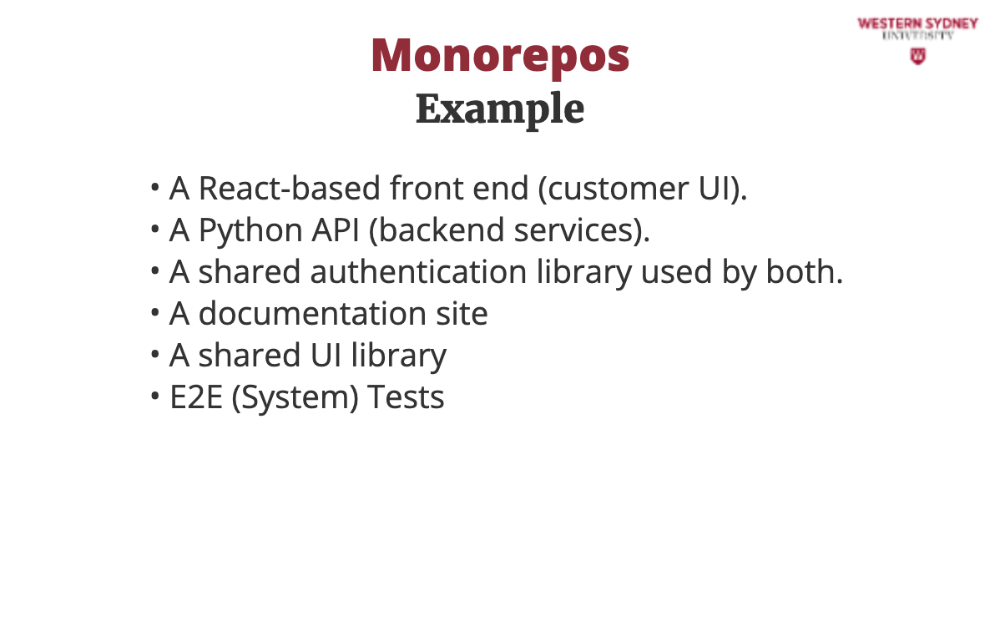
Imagine a large e-commerce platform like Amazon. It has separate teams working on the following packages. In a polyrepo setup, these would be separate repositories, leading to dependency mismatches. With a monorepo, all projects stay in sync, making collaboration smoother
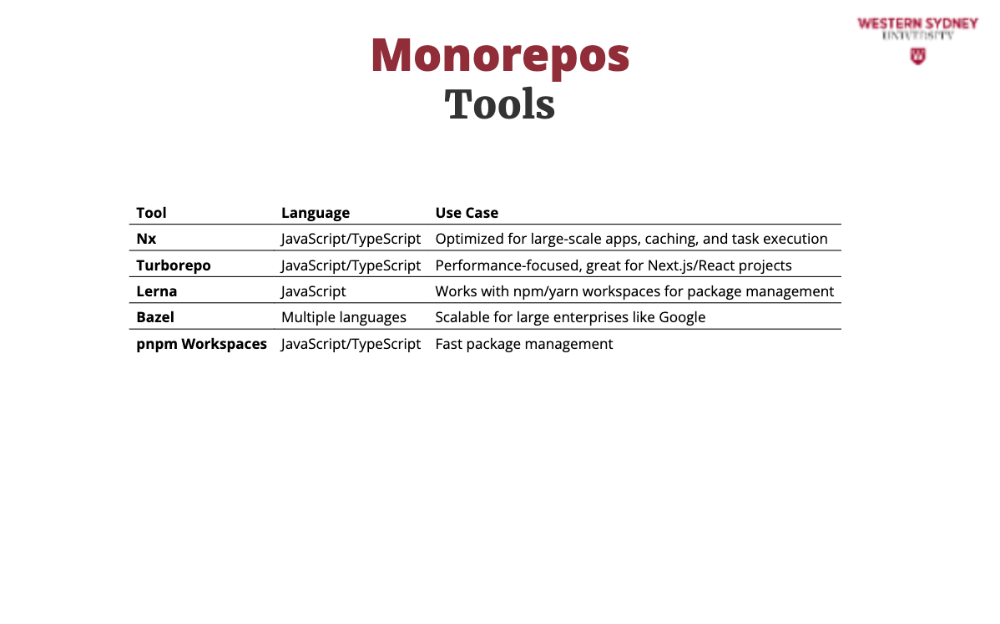
Monorepos typically use workspace management tools to handle multiple projects efficiently. These tools ensure that dependencies are shared and optimised. These are some of the popular monorepo tools. In our case we will use turborepo and pnpm for package management.

Let's review the key benefits of Monorepos with some examples.

In monorepos, teams can easily reuse code across projects. Shared libraries (e.g., authentication, UI components) stay in sync without extra work. For example a React component library can be shared between the front end and an admin dashboard without publishing it as an npm package.

Since everything exists in one repository, dependencies remain consistent. If the back end and front end rely on the same API contracts, changes are synchronized.

With a monorepo, refactoring is safer. Developers can update all affected projects at once, avoiding breaking changes across repositories. For example, if the API changes from /v1/users to /v2/users, the front-end and back-end updates can be made in a single commit.

CI/CD systems (like GitHub Actions, GitLab CI, or Jenkins) can optimize workflows by running only the affected parts of the code. For example, if a developer updates only the front end, tests and deployments run only for the front end, not the entire stack.

Teams working on different aspects of the application (UI, API, DevOps) can see and contribute to changes in one place, improving teamwork.
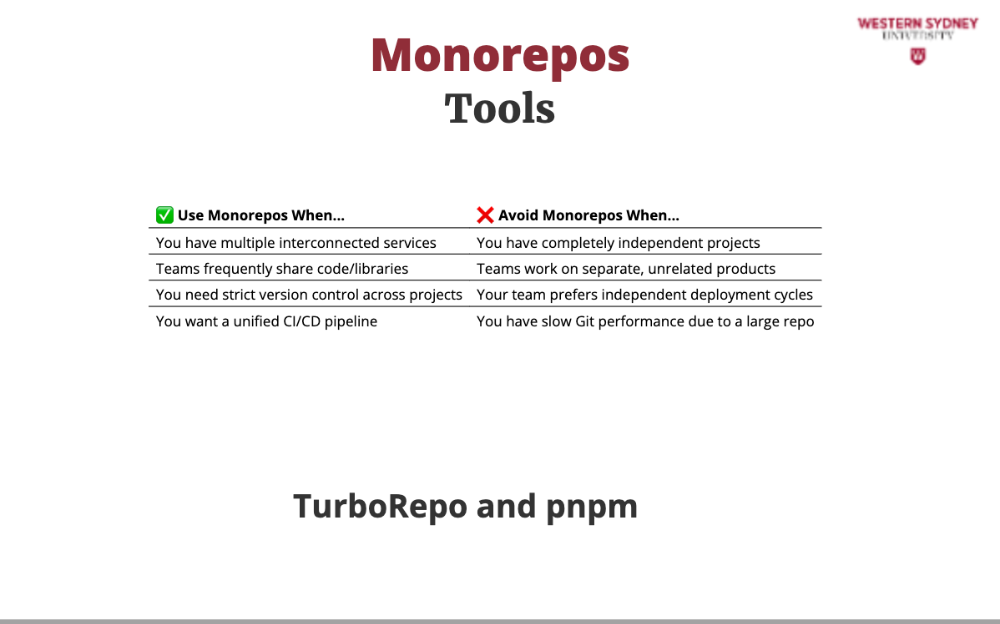
Use Monorepos when you have multiple interconnected services, share code or libraries, need strict version control across all projects, or create optimised, unified CI/CD pipelines. Please don't use Monorepos when your projects are completely independent or when you prefer to have independent deployment cycles.

In the next section, we'll show you how to set up your own Turborepo and how to install and manage packages with pnpm.